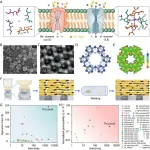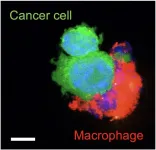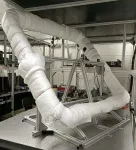(Press-News.org) WHAT:
The amount of infectious H5N1 influenza viruses in raw milk rapidly declined with heat treatment in laboratory research conducted by scientists at the National Institute of Allergy and Infectious Diseases (NIAID), part of the National Institutes of Health. However, small, detectable amounts of infectious virus remained in raw milk samples with high virus levels when treated at 72 degrees Celsius (161.6 degrees Fahrenheit) for 15 seconds—one of the standard pasteurization methods used by the dairy industry. The authors of the study stress, however, that their findings reflect experimental conditions in a laboratory setting and are not identical to large-scale industrial pasteurization processes for raw milk. The findings were published today in the New England Journal of Medicine.
In late March 2024, United States officials reported an outbreak of highly pathogenic avian influenza virus called HPAI H5N1 among dairy cows in Texas. To date, 95 cattle herds across 12 states have been affected, with three human infections detected in farm workers with conjunctivitis. Although the virus so far has shown no genetic evidence of acquiring the ability to spread from person to person, public health officials are closely monitoring the dairy cow situation as part of overarching pandemic preparedness efforts.
Given the limited data on the susceptibility of avian influenza viruses to pasteurization methods used by the dairy industry, scientists at NIAID’s Rocky Mountain Laboratories sought to quantify the stability of H5N1 virus in raw milk when tested at different time intervals at 63℃ (145.4 degrees Fahrenheit) and 72℃, the temperatures most common in commercial dairy pasteurization processes. The scientists isolated HPAI H5N1 from the lungs of a dead mountain lion in Montana. Then they mixed these viral isolates with raw, unpasteurized cow milk samples and heat-treated the milk at 63℃ and 72℃ for different periods of time. The samples were then cell-cultured and tested to determine if live virus remained and if so, how much.
They found that 63℃ caused a marked decrease (1010-fold) in infectious H5N1 virus levels within 2.5 minutes and note that standard bulk pasteurization of 30 minutes would eliminate infectious virus. At 72℃, they observed a decrease (104-fold) in infectious virus within five seconds, however, very small amounts of infectious virus were detected after up to 20 seconds of heat treatment in one out of three samples. “This finding indicates the potential for a relatively small but detectable quantity of H5N1 virus to remain infectious in milk after 15 seconds at 72℃ if the initial virus levels were sufficiently high,” the authors note.
The scientists stress that their measurements reflect experimental conditions, should be replicated with direct measurement of infected milk in commercial pasteurization equipment and should not be used to draw any conclusions about the safety of the U.S. milk supply. Additionally, a limitation of their study was the use of raw milk samples spiked with H5N1 virus, whereas raw milk from cows infected with H5N1 influenza may have a different composition or contain cell-associated virus that may impact heat effects. The authors conclude that although gastrointestinal infections with HPAI H5N1 virus have occurred in several species of mammals, it remains unknown whether ingesting live H5N1 in raw milk could cause illness in people.
To date, the U.S. Food and Drug Administration concludes that the totality of evidence continues to indicate that the commercial milk supply is safe. While laboratory benchtop studies provide important, useful information, there are limitations that challenge inferences to real world commercial processing and pasteurization. The FDA conducted an initial survey of 297 retail dairy products collected at retail locations in 17 states and represented products produced at 132 processing locations in 38 states. All of the samples were found to be negative for viable virus. These results underscore the opportunity to conduct additional studies that closely replicate real-world conditions. FDA, in partnership with USDA, is conducting pasteurization validation studies – including the use of a homogenizer and continuous flow pasteurizer. Additional results will be made available as soon as they are available.
ARTICLE:
F Kaiser et al. Inactivation rate of highly pathogenic avian influenza H5N1 virus (clade 2.3.4.4b) in raw milk at 63 and 72 degrees Celsius. The New England Journal of Medicine DOI: 10.1056/NEJMc2405488 (2024).
WHO:
Vincent Munster, Ph.D., and Emmie de Wit, Ph.D., senior investigators in NIAID’s Laboratory of Virology at the Rocky Mountain Laboratories in Hamilton, Mont., are available to discuss the findings.
CONTACT:
To schedule interviews, please contact the NIAID News and Science Writing Branch, (301) 402-1663, niaidnews@niaid.nih.gov.
NIAID conducts and supports research—at NIH, throughout the United States, and worldwide—to study the causes of infectious and immune-mediated diseases, and to develop better means of preventing, diagnosing and treating these illnesses. News releases, fact sheets and other NIAID-related materials are available on the NIAID website.
About the National Institutes of Health (NIH): NIH, the nation's medical research agency, includes 27 Institutes and Centers and is a component of the U.S. Department of Health and Human Services. NIH is the primary federal agency conducting and supporting basic, clinical, and translational medical research, and is investigating the causes, treatments, and cures for both common and rare diseases. For more information about NIH and its programs, visit http://www.nih.gov/.
NIH...Turning Discovery Into Health®
END
“Elucidating the function of Erk5 in cancer [...] will contribute to a better understanding of cancer pathogenesis and the development of novel therapeutic strategies.”
BUFFALO, NY- June 14, 2024 – A new editorial paper was published in Oncoscience (Volume 11) on May 20, 2024, entitled, “Role of Erk5 expressed in bone marrow mesenchymal stem cells on bone homeostasis and its potential applications in cancer treatment.”
In their new editorial, researchers Tetsuhiro Horie and Eiichi Hinoi from Kanazawa ...
(MEMPHIS, Tenn. – June 14, 2024) Scientists at St. Jude Children’s Research Hospital today announced a way to improve molecular scale distance measurements using single-molecule fluorescence resonance energy transfer (smFRET). smFRET quantifies the excitation and emission properties of chemicals called fluorophores.
When an excited electron in the fluorophore relaxes, it emits light after a delay, causing the molecule to glow (fluoresce). However, fluorophores don’t always fluoresce after excitation. Instead, through quantum mechanical ...
SAN ANTONIO, June 14, 2024 – The University of Texas Health Science Center at San Antonio School of Dentistry is preparing to launch its Center for Regenerative Sciences, a new research initiative that aims to position the university at the forefront of regenerative dentistry and medicine.
“The center will provide new avenues for interdisciplinary collaborations to accelerate the translation of preclinical discoveries into therapeutic benefit for patients suffering from dental, oral and craniofacial diseases,” said Yong-Hee Chun, DDS, PhD, MS, associate professor of ...
In a major breakthrough for lithium recovery technologies, researchers from the Qingdao Institute of Bioenergy and Bioprocess Technology (QIBEBT) of the Chinese Academy of Sciences, together with collaborators, have developed a crystalline carbon nitride membrane that could transform the lithium extraction industry.
The innovative design, which mimics biological ion channels, shows remarkable efficiency and durability in separating lithium ions from magnesium ions in salt-lake brine.
The study, published in Science Advances on June 14, introduces a ...
KEY TAKEAWAYS
Lung cancer is the most diagnosed cancer and the leading cause of cancer death globally, representing an urgent need for new and improved treatment options.
Researchers from Brigham and Women’s Hospital developed a new nanomedicine therapy that delivers anticancer drugs to lung cancer cells and enhances the immune system's ability to fight cancer.
The research must undergo rigorous toxicology studies before moving into clinical testing in patients but represents a potential treatment for patients who have failed to respond to traditional immunotherapy.
Researchers at Brigham and ...
Atlanta, GA – June 14, 2024 – Antibiotics in the uppermost water surface, known as the sea surface microlayer, can significantly affect the number of bacteria present and contribute to the adaptation of marine bacteria against widely used antibiotics. In new research presented at ASM Microbe, scientists directly assessed the potential effects of antibiotics on bacterial diversity in Jade Bay, Southern North Sea, Germany.
The researchers tested the susceptibility and resistance of marine bacteria to ofloxacin, ...
Atlanta, GA—Sepsis is a life-threatening infection complication and accounts for 1.7 million hospitalizations and 350,000 deaths annually in the U.S. Fast and accurate diagnosis is critical, as mortality risk increases up to 8% every hour without effective treatment. However, the current diagnostic standard is reliant on culture growth, which typically takes 2-3 days. Doctors may choose to administer broad-spectrum antibiotics until more information is available for an accurate diagnosis, but these can have limited efficacy and potential toxicity to the patient.
In a study presented at ASM Microbe, a team from Day Zero Diagnostics unveiled a novel approach to antimicrobial susceptibility ...
A team of researchers led by Philip Walther at the University of Vienna carried out a pioneering experiment where they measured the effect of the rotation of Earth on quantum entangled photons. The work, just published in Science Advances, represents a significant achievement that pushes the boundaries of rotation sensitivity in entanglement-based sensors, potentially setting the stage for further exploration at the intersection between quantum mechanics and general relativity.
Optical Sagnac interferometers are the most sensitive devices to rotations. They have been pivotal in our understanding of fundamental physics since the early years of the last century, contributing to establish ...
Atlanta, Ga. – June 14, 2023 – Researchers have demonstrated that a new technology could quickly and accurately diagnose bloodstream infections. The study findings were reported at ASM Microbe, the annual meeting of the American Society for Microbiology.
“There is a need to be able to rapidly and accurately diagnose bacteremia in newborn babies. They are especially susceptible to long-term morbidities and mortality the longer they go without treatment, or even with inaccurate treatment for bloodstream infections or sepsis,” said presenting study author April Aralar, Ph.D., a ...
Background: We previously demonstrated the successful use of in vivo CRISPR gene editing to delete 4-hydroxyphenylpyruvate dioxygenase (HPD) to rescue mice deficient in fumarylacetoacetate hydrolase (FAH), a disorder known as hereditary tyrosinemia type 1 (HT1). The aim of this study was to develop an ex vivo gene-editing protocol and apply it as a cell therapy for HT1.
Methods: We isolated hepatocytes from wild-type (C57BL/6J) and Fah-/- mice and then used an optimized electroporation protocol to deliver Hpd-targeting CRISPR-Cas9 ribonucleoproteins into hepatocytes. Next, hepatocytes were transiently incubated in ...






